Mechanical Engineer Cover Letter Tips
A compelling cover letter is your first opportunity to impress a potential employer. For a mechanical engineer, a well-crafted cover letter can be the deciding factor in securing an interview. It’s more than just a formality it’s a chance to showcase your skills, experience, and enthusiasm for the role. This guide provides essential tips to help you write a standout cover letter that gets noticed by hiring managers and lands you your dream job. Remember, the goal is to demonstrate how your qualifications align with the company’s needs and the specific requirements of the position. Taking the time to create a targeted, well-written cover letter is an investment in your career.
Understand the Purpose of a Cover Letter
The primary purpose of a cover letter is to introduce yourself and explain why you’re a perfect fit for the job. Unlike your resume, which provides a summary of your experience, a cover letter allows you to tell a story. It gives you the space to highlight specific achievements, explain any gaps in your employment history, and express your genuine interest in the company and the position. Consider it your personal sales pitch. This is where you connect your skills and experience to the specific requirements of the role, demonstrating your understanding of the company’s needs and showing how you can contribute to their success. It’s a chance to go beyond the facts and convey your personality and passion for mechanical engineering.
Highlight Key Skills and Experience
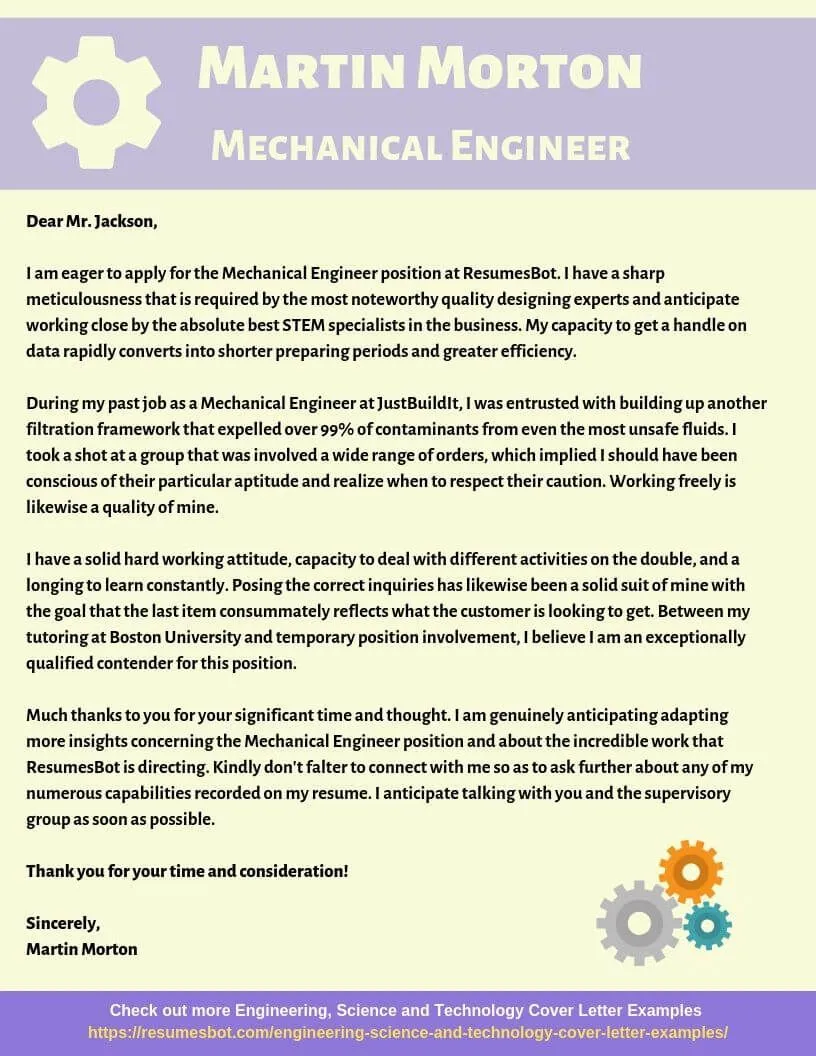
Carefully review the job description and identify the key skills and experiences the employer is seeking. Then, use your cover letter to provide concrete examples of how you’ve demonstrated those skills in the past. Quantify your achievements whenever possible. For example, instead of saying you ‘managed projects’, say ‘Managed projects resulting in a 15% reduction in costs and a 10% increase in efficiency.’ This approach not only shows that you have the required skills but also proves that you can deliver results. Furthermore, tailor your examples to the specific requirements of the role, ensuring the employer sees how your experience directly relates to their needs. Use action verbs to describe your accomplishments and focus on what you achieved.
Tailor Your Cover Letter
Avoid sending generic cover letters. Each cover letter should be customized to the specific job and company you’re applying for. This requires research and effort, but it significantly increases your chances of getting noticed. Start by addressing the hiring manager by name, if possible. Then, demonstrate your understanding of the company’s mission, values, and recent projects. Reference specific aspects of the job description and explain how your skills and experience align with their needs. Showing that you’ve taken the time to understand the company demonstrates your genuine interest and commitment. Customize the letter by using keywords from the job description and mentioning the company’s name throughout the document.
Research the Company
Before you start writing, research the company thoroughly. Visit their website, read news articles, and check their social media profiles. Understand their products or services, their target market, and their recent projects or achievements. This research will not only help you tailor your cover letter but also enable you to ask informed questions during the interview. Understanding the company culture is equally important. Find out about their values, work environment, and any recent awards or recognition they’ve received. This information will help you demonstrate how your skills and experience align with their company culture and mission. Show that you’re genuinely interested in the company by referencing specific projects or initiatives.
Format Your Cover Letter Properly
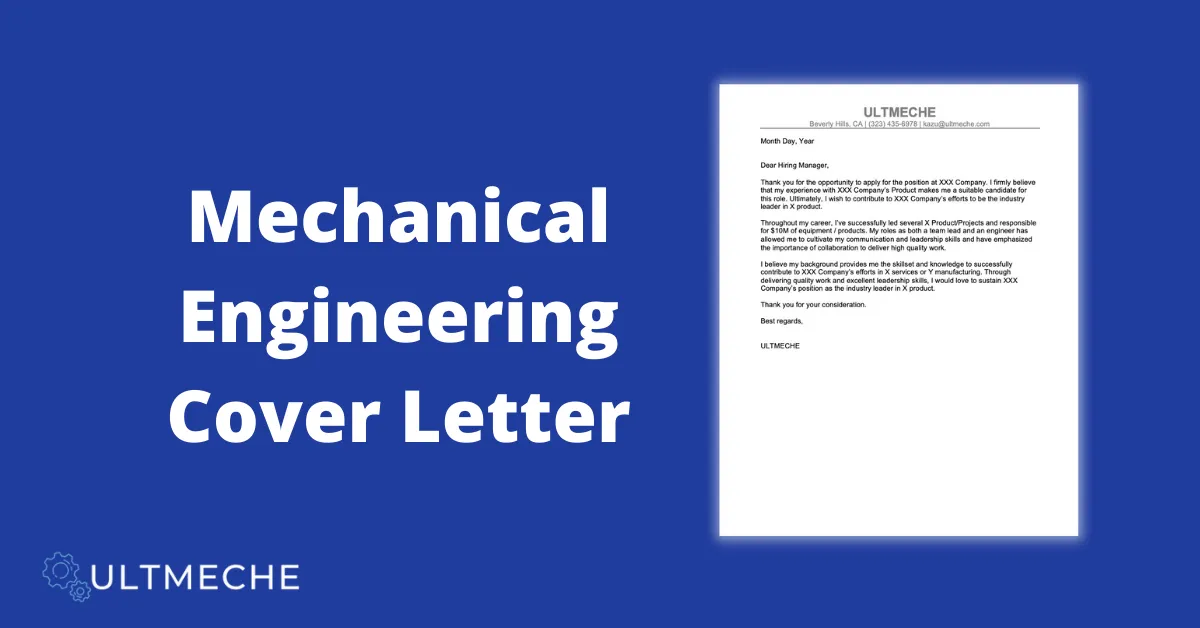
Proper formatting is essential for a professional-looking cover letter. Use a standard font like Times New Roman or Arial, and keep the font size between 11 and 12 points. Maintain consistent margins (typically one inch) throughout the document. Your cover letter should be concise and easy to read, ideally fitting on a single page. Break up large blocks of text with short paragraphs and use bullet points to highlight key skills or achievements. Include your contact information (name, phone number, email address, and LinkedIn profile URL) at the top of the letter. Ensure that your name and the date are clearly visible and that the letter is well-organized, with a clear introduction, body paragraphs, and conclusion. See image for reference.
Use a Professional Tone
Your cover letter should reflect a professional and respectful tone. Avoid slang, jargon, or overly casual language. Use formal language and correct grammar and punctuation. Be polite and courteous, and always address the hiring manager appropriately. Avoid using contractions and use a confident but humble tone. Demonstrate your enthusiasm for the role and the company, but avoid sounding overly eager or desperate. Highlight your qualifications and skills with confidence, but avoid arrogance. Proofread your cover letter carefully to eliminate any errors that could undermine your professionalism.
Proofread Your Cover Letter
Proofreading is a critical step that should never be skipped. Typos, grammatical errors, and formatting mistakes can create a negative impression and detract from your qualifications. After you’ve finished writing your cover letter, take a break before proofreading. Then, read through the document multiple times, looking for any errors. Use a spell checker, but also carefully review each sentence for clarity and accuracy. Ask a friend or family member to proofread your cover letter as well. A fresh pair of eyes can often catch mistakes you might miss. Pay attention to the details, such as correct names, dates, and company information. Ensure that your cover letter is error-free before submitting it.
Mechanical Engineering Skills to Showcase
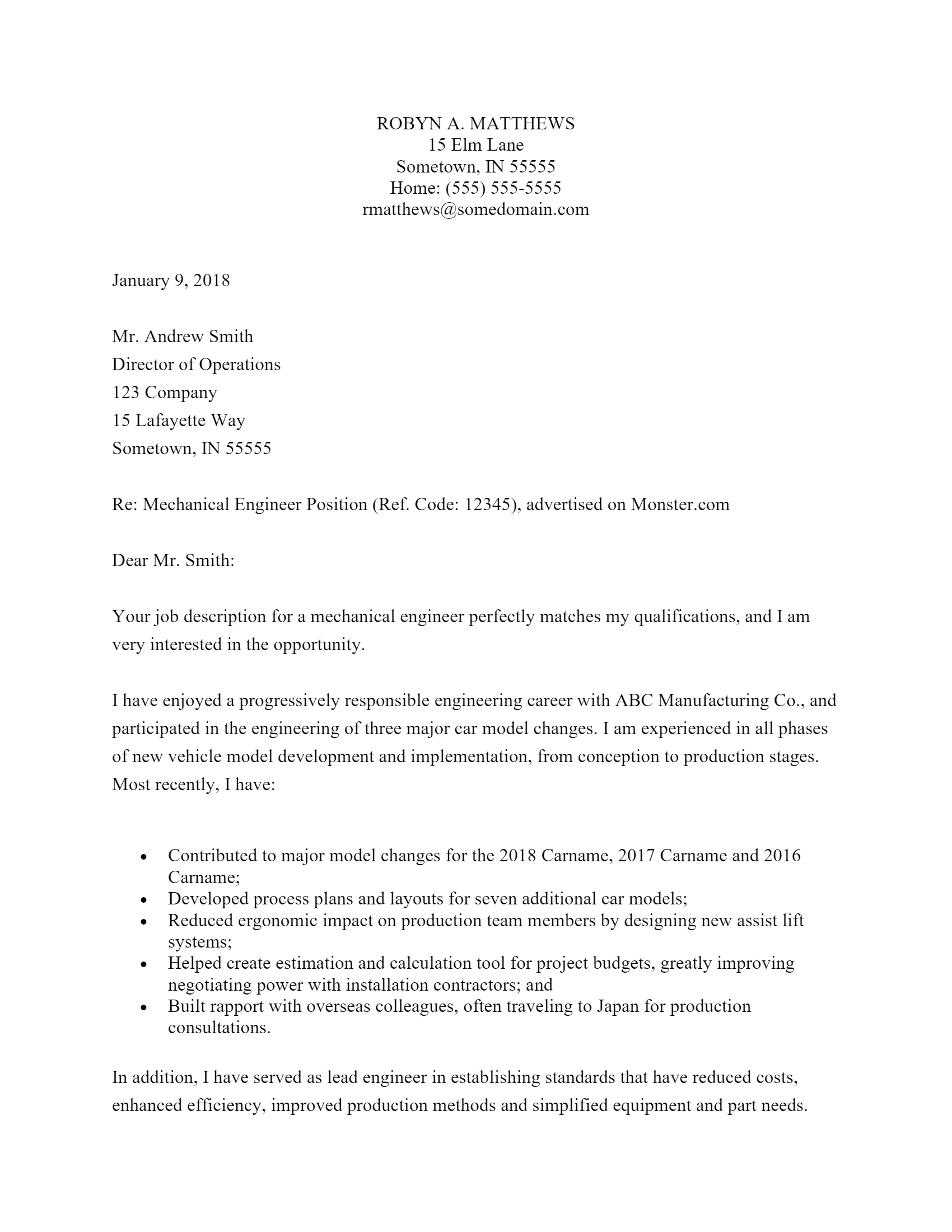
Technical Skills
Mechanical engineers should highlight their technical skills, which are the cornerstone of their profession. These include proficiency in areas such as thermodynamics, fluid mechanics, heat transfer, and materials science. Mention your experience with different mechanical systems, such as HVAC systems, manufacturing processes, and robotics. Demonstrate your understanding of design principles, including CAD software and engineering analysis tools. Mention specific software you are proficient in, and quantify your achievements. For example, state how you used simulation software to improve a design’s efficiency or how you optimized a manufacturing process to reduce costs. Highlight any relevant certifications you hold.
Software Proficiency
In today’s engineering landscape, software proficiency is essential. Highlight your experience with relevant software, such as CAD software (e.g., AutoCAD, SolidWorks, Inventor), FEA software (e.g., ANSYS, COMSOL), and CAM software. Specify the software packages you are comfortable using, including experience with simulation tools and data analysis. Showcase your ability to use these tools to design, analyze, and optimize mechanical systems. If you’ve used software to solve specific problems or improve existing designs, provide details. Including this information demonstrates your ability to apply theoretical knowledge to practical applications. Software proficiency is a critical aspect of a mechanical engineer’s skill set; showing a wide range of expertise can set your application apart. See image for reference.
Project Management
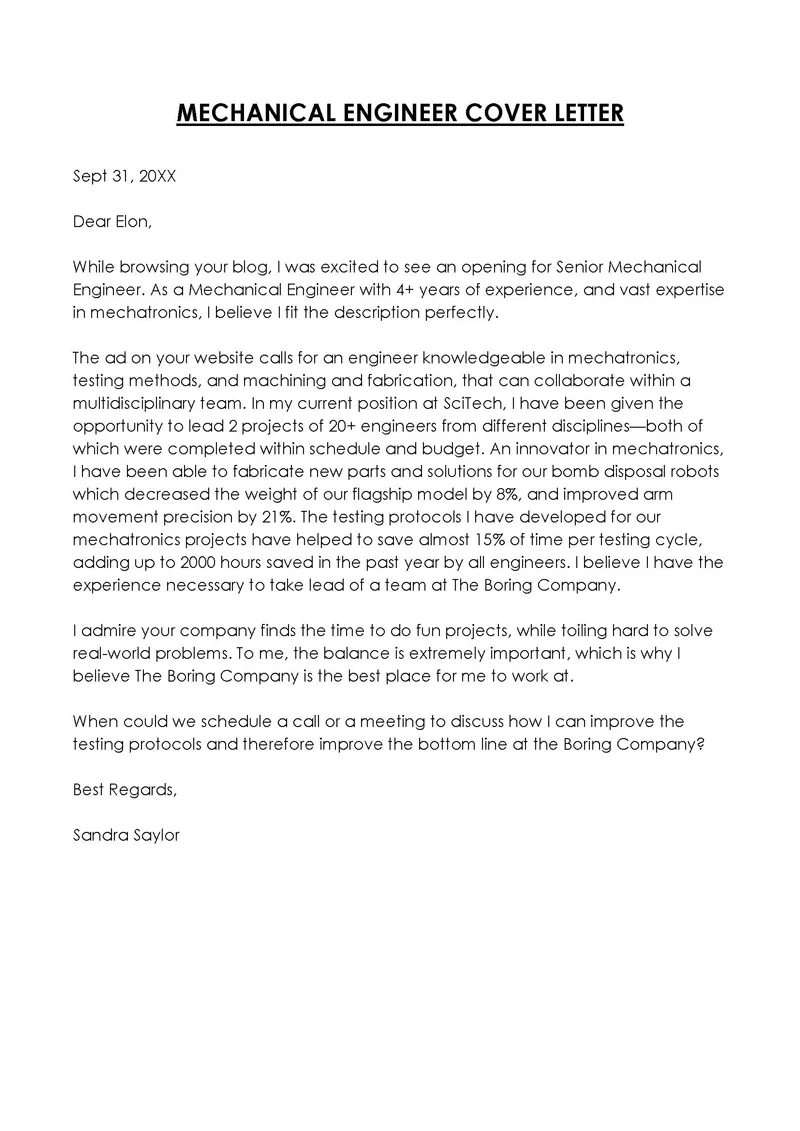
Project management skills are highly valued in mechanical engineering. Highlight your ability to plan, organize, and execute engineering projects. Describe your experience managing project budgets, timelines, and resources. Mention any project management methodologies you’re familiar with (e.g., Agile, Waterfall). Provide specific examples of projects you’ve led or contributed to. Quantify your achievements by mentioning project outcomes, such as on-time delivery, cost savings, or improved efficiency. Also showcase your ability to work with cross-functional teams, communicate effectively, and solve problems. See image for reference.
Communication and Teamwork
Effective communication and teamwork skills are crucial for success in mechanical engineering. Highlight your ability to communicate technical information clearly and concisely, both in writing and verbally. Describe your experience collaborating with other engineers, designers, and stakeholders. Mention your experience with giving presentations, writing technical reports, and participating in design reviews. Provide examples of how you’ve resolved conflicts, facilitated teamwork, and motivated others. Explain how you collaborate with other departments, like manufacturing and sales. Highlight your ability to listen, provide constructive feedback, and work effectively in diverse teams. See image for reference.
Common Mistakes to Avoid
Generic Cover Letters

Sending a generic cover letter is one of the biggest mistakes you can make. Generic letters that don’t address the specific requirements of the job, or reference the company’s needs will often be discarded. Avoid using generic phrases or clichés. Tailor each cover letter to the specific job you are applying for, by using keywords from the job description, addressing the hiring manager by name and referencing the company. Generic letters demonstrate a lack of effort and interest, signaling to the employer that you’re not truly committed to the role. This shows a lack of effort in getting to know the company.
Typos and Grammatical Errors
Typos and grammatical errors can undermine your credibility and professionalism. Even a few minor errors can create a negative impression and lead to your application being rejected. Always proofread your cover letter carefully before submitting it. Use spell check and grammar check tools, but don’t rely on them entirely. Read through the document multiple times, and ask a friend or family member to proofread it as well. Ensure that the formatting is consistent and that all information is accurate. Poor grammar suggests a lack of attention to detail and professionalism and indicates that you are not careful with your work. See image for reference.
Lack of Specific Examples
Avoid making vague statements about your skills and experience. Instead, provide specific examples that illustrate your qualifications and achievements. Instead of saying that you are a ‘good problem-solver’, describe a specific problem you solved and the results you achieved. Quantify your accomplishments whenever possible, and provide concrete evidence of your capabilities. Without specific examples, your cover letter will lack impact and fail to convince the employer of your suitability for the role. The details and examples will demonstrate that you not only possess the required skills, but can also successfully apply them to meet challenges.
Ignoring the Job Description
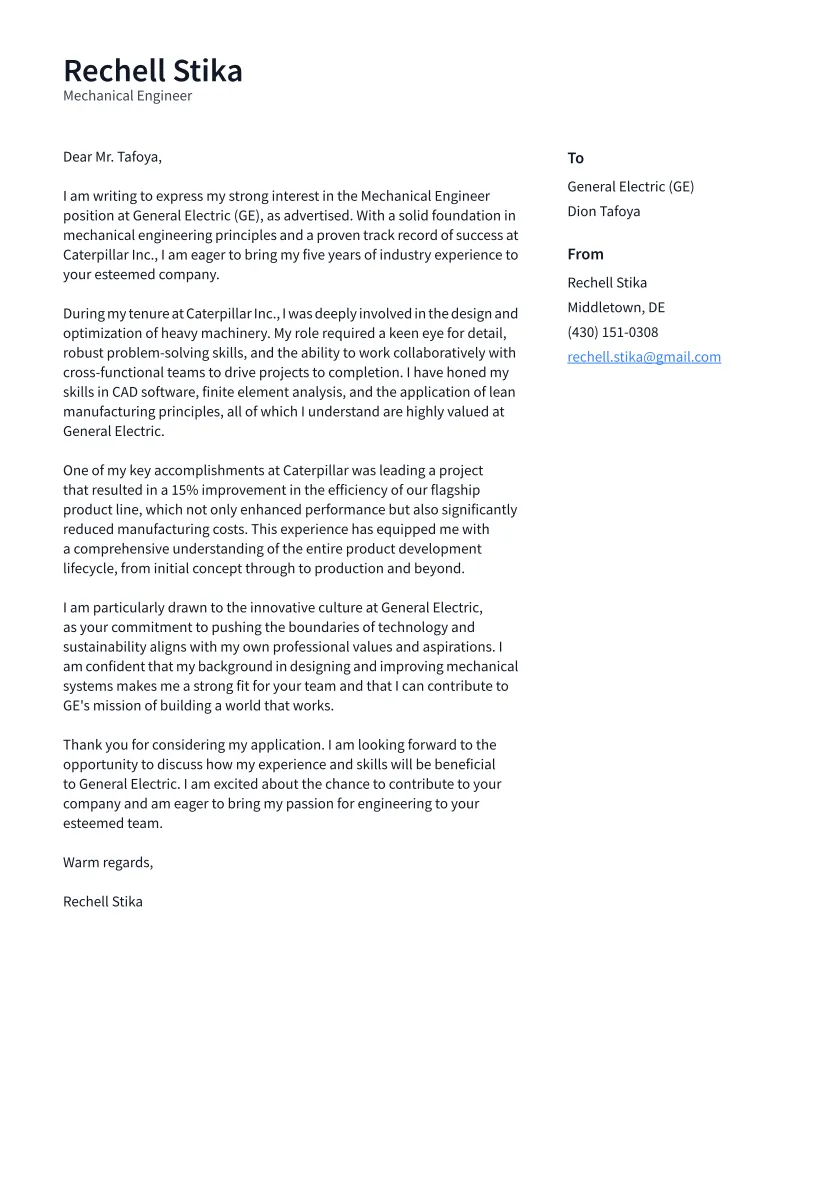
Failing to address the specific requirements of the job description is a major mistake. Employers create job descriptions to outline the skills, experience, and qualifications they’re seeking in a candidate. Carefully review the job description and tailor your cover letter to demonstrate that you possess those requirements. Use keywords from the job description throughout your cover letter. Reference specific skills, experience, and achievements that align with the job requirements. This approach shows the employer that you have taken the time to understand their needs and are a good fit for the role. Failing to address the requirements shows that you didn’t read or understand the job posting.
Tips for a Strong Closing
Express Enthusiasm
End your cover letter on a positive note by expressing your enthusiasm for the role and the company. Show the hiring manager that you’re genuinely interested in the opportunity and excited about the prospect of joining their team. Make it clear why you are a good fit and reiterate your interest in the position. Avoid generic closing statements and express your enthusiasm genuinely. If you have a particular project or aspect of the job that excites you, mention it. This demonstrates your commitment to the role and your eagerness to make a contribution.
Reiterate Your Interest

In the closing paragraph, reiterate your interest in the position and the company. Summarize why you are a great fit for the role and what you can bring to the table. This reinforces the key points from your cover letter and ensures that the hiring manager remembers your qualifications and enthusiasm. Thank the hiring manager for their time and consideration. Make it clear that you are eager to learn more about the opportunity and are available for an interview. Keep the closing concise and focused, and reiterate your key skills and experience. See image for reference.
Include a Call to Action
End your cover letter with a clear call to action. Tell the hiring manager what you want them to do next, such as scheduling an interview. Make it easy for them to contact you by including your phone number and email address. Express your availability for an interview and reiterate your enthusiasm for the role. A strong call to action will help move your application forward and increase your chances of getting hired. Ensure the call to action is clear and direct. Thank the hiring manager for their time and consideration and state your eagerness for a response. See image for reference.
